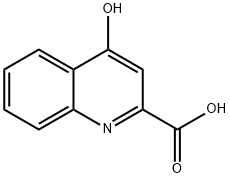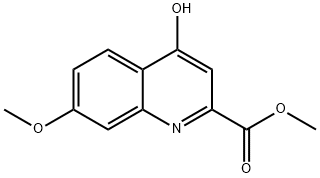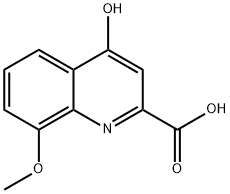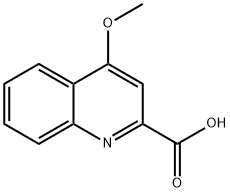KYNURENIC ACID
- CAS NO.:492-27-3
- Empirical Formula: C10H7NO3
- Molecular Weight: 189.17
- MDL number: MFCD00006753
- EINECS: 207-751-5
- SAFETY DATA SHEET (SDS)
- Update Date: 2025-01-27 09:38:02

What is KYNURENIC ACID?
The Uses of KYNURENIC ACID
Kynurenic acid has been used as a constituent in dissection saline solution for embryonic cerebral cortical cells and human primary astrocytes. It has also been used as a medium supplement for murine intestinal epithelial cell line, MODE-K and induced pluripotent stem cell (iPSC)-derived neurons cells.
The Uses of KYNURENIC ACID
A product of L-Tryptophan metabolism, possessing neruoactive activity having antiexcitotoxic and anticonvulsant properties.
The Uses of KYNURENIC ACID
An antagonist of NMDA and AMPA/kainate receptors
What are the applications of Application
Kynurenic acid is an antagonist of NMDA and AMPA/kainate receptors
Definition
ChEBI: Kynurenic acid is a quinolinemonocarboxylic acid that is quinoline-2-carboxylic acid substituted by a hydroxy group at C-4. It has a role as a G-protein-coupled receptor agonist, a NMDA receptor antagonist, a nicotinic antagonist, a neuroprotective agent, a human metabolite and a Saccharomyces cerevisiae metabolite. It is a monohydroxyquinoline and a quinolinemonocarboxylic acid. It is a conjugate acid of a kynurenate.
Biological Activity
Broad spectrum EAA antagonist.
Biochem/physiol Actions
Kynurenic acid (KynA) is a non-selective antagonist of N-methyl-d-aspartate (NMDA), α-amino-3-hydroxy-5-methyl-4-isoxazolepropionic acid (AMPA) and kainate receptors. It blocks kainic acid neurotoxicity. Kynurenic acid also blocks nicotinic acetylcholine receptors. It is a by-product of tryptophan catabolic pathway. Kynurenic acid is a neuromodulator and controls the levels of glutamate, dopamine, acetylcholine and α-aminobutyric acid (GABA). KynA controls neuroendocrine functions and altered levels of KynA is a potential marker in depression, schizophrenia Alzheimer′s and Huntington′s diseases. Normal levels of KynA in the brain is crucial for the cognitive function.
storage
Room temperature
Purification Methods
Crystallise the acid from absolute EtOH. The methyl ester crystallises from MeOH with m 224-226o. [Greenstein & Winitz The Chemistry of the Amino Acids J. Wiley, Vol 3 p2723 1961, Beilstein 22 II 174, 22 III/IV 2245, 22/6 V 280.]
Properties of KYNURENIC ACID
| Melting point: | 275 °C (dec.)(lit.) |
| Boiling point: | 324.41°C (rough estimate) |
| Density | 1.3175 (rough estimate) |
| refractive index | 1.5400 (estimate) |
| storage temp. | Sealed in dry,Room Temperature |
| solubility | DMSO : 9 mg/mL (47.58 mM; Need ultrasonic and warming) |
| form | Off-white to tan powder. |
| pka | 1.08±0.30(Predicted) |
| color | White to Gray to Brown |
| Water Solubility | 8.92g/L(100 ºC) |
| Merck | 14,5327 |
| BRN | 147451 |
| CAS DataBase Reference | 492-27-3(CAS DataBase Reference) |
| EPA Substance Registry System | 2-Quinolinecarboxylic acid, 4-hydroxy- (492-27-3) |
Safety information for KYNURENIC ACID
Computed Descriptors for KYNURENIC ACID
New Products
3-Iodophenylacetic acid 3-Pyridineacetonitrile, α-hydroxy- 2-Propanamine, 1-chloro-, hydrochloride (9CI) 3-(hexyloxy)-4-(pyridin-3-yl)-1,2,5-thiadiazole 2-Hexyn-1-ol Dibenzo-18-crown-6 Nickel(II) perchlorate hexahydrate, 98% 4-Bromophenylacetonitrile, 95% 3-Bromo-4-fluoroaniline, 97% Sodium tetraborate decahydrate, 98% Palladium(II) acetate, trimer, Pd 99% 4-Bromo-2-chlorotoluene, 97% N N Dimethylformamide Dimethyl Acetal (Dmf Dma) 2,3-Dichloro Benzoyl Cyanide [Side Chain] Bis(2-Chloroethyl) Amine Hydrochloride L-Glutamic Acid Diethyl Ester Hydrochloride 5-(Difluoromethoxy)-2-Mercaptobenzimidazole 1-Ethyl-3-(3-Dimethylaminopropyl)-Carbodiimide Hydrochloride [EDC Hcl] 1,4-Napthoquinone Bromoiodomethane Sodium Bicarbonate Methylene Dichloride (MDC) Ethyl Acetate Indole-3-Carbinol (I3C)Related products of tetrahydrofuran








You may like
-
 Kynurenic acid CAS 492-27-3View Details
Kynurenic acid CAS 492-27-3View Details
492-27-3 -
 Kynurenic acid CAS 492-27-3View Details
Kynurenic acid CAS 492-27-3View Details
492-27-3 -
 17604-74-9 3-Pyridineacetonitrile, α-hydroxy- 98+View Details
17604-74-9 3-Pyridineacetonitrile, α-hydroxy- 98+View Details
17604-74-9 -
 131987-69-4 98+View Details
131987-69-4 98+View Details
131987-69-4 -
 Cyclohexane, (2-propynyloxy)- 67967-07-1 98+View Details
Cyclohexane, (2-propynyloxy)- 67967-07-1 98+View Details
67967-07-1 -
 2-Propanamine, 1-chloro-, hydrochloride (9CI) 98+View Details
2-Propanamine, 1-chloro-, hydrochloride (9CI) 98+View Details
5968-21-8 -
 3-Iodophenylacetic acid 1878-69-9 98+View Details
3-Iodophenylacetic acid 1878-69-9 98+View Details
1878-69-9 -
 132945-75-6 (S)-1-Boc-3-methanesulfonyloxy-pyrrolidine 98+View Details
132945-75-6 (S)-1-Boc-3-methanesulfonyloxy-pyrrolidine 98+View Details
132945-75-6
